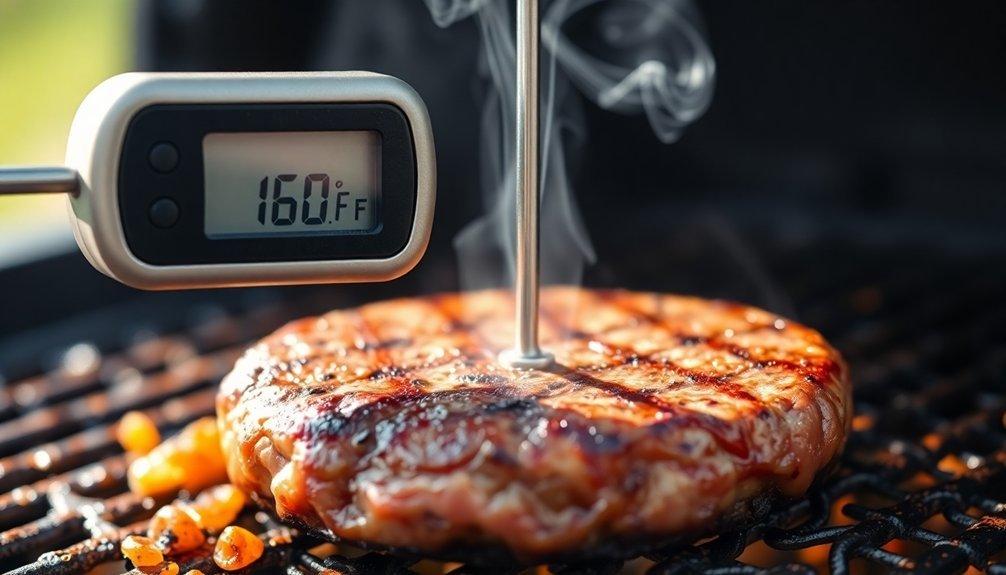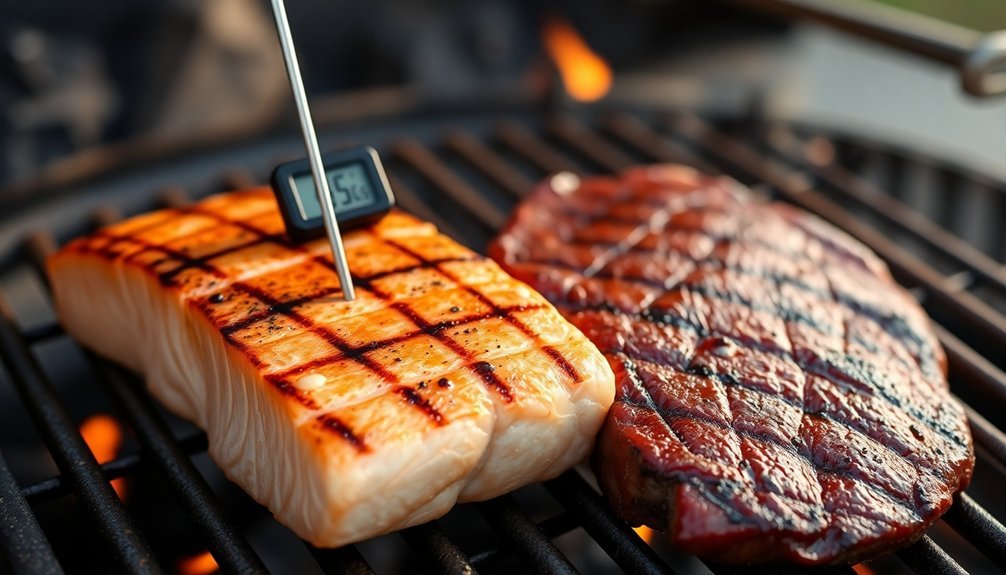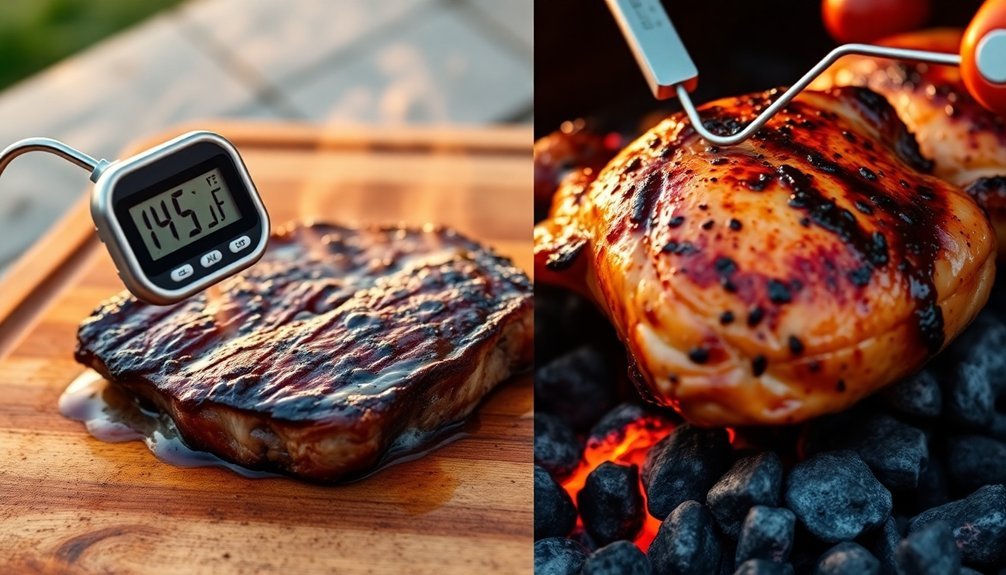To guarantee safe outdoor cooking, you'll need to follow three critical temperature guidelines. Cook all ground meats (including burgers and sausages) to 160°F to eliminate harmful bacteria like E. coli. Your poultry must reach 165°F to kill dangerous pathogens like Salmonella, while fish and whole cuts of beef should hit 145°F for safe consumption. Don't rely on meat color alone – always use a reliable food thermometer to check multiple spots in your foods. These temperatures are just the beginning of mastering safe outdoor cooking techniques that'll protect your family and guests.
Ground Meats at 160°F

Three critical factors make cooking ground meats to 160°F essential for food safety.
First, this temperature is the only proven way to kill harmful bacteria like E. coli O157:H7, which can make you seriously ill.
Second, you can't rely on the meat's color to determine if it's safe – you'll need a food thermometer to verify the internal temperature accurately.
Third, proper temperature control protects vulnerable people, including children and the elderly, from foodborne illness.
When you're grilling outdoors, you'll need to be extra vigilant about reaching this temperature consistently. Bacteria of concern commonly found in ground meats cannot be detected by sight, smell, or taste.
Keep your thermometer handy and check multiple spots in your burgers or other ground meat dishes.
Don't forget to clean your tools and surfaces thoroughly before and after handling raw ground meats to prevent cross-contamination.
Poultry Products at 165°F
Since poultry harbors dangerous bacteria like Salmonella and Campylobacter, cooking it to 165°F is non-negotiable for food safety.
You'll need to insert your meat thermometer into the thickest part of the meat, avoiding bones and fat, to get an accurate reading. Check multiple spots to verify even heating.
While dark meat like legs and thighs is safe at 165°F, you might want to cook these pieces to 170-175°F for better tenderness, as higher temperatures help break down connective tissue.
Don't worry if the dark meat still appears pink – it's safe as long as it reaches the proper temperature. For chicken breasts, 165°F is perfect.
Remember to clean your thermometer with hot soapy water before and after each use, and don't cook frozen poultry without following package instructions. Single minimum temperature guidelines have been established by the USDA to ensure consumer confidence in food safety.
Fish and Steaks at 145°F

Understanding proper cooking temperatures for fish and steaks helps guarantee both food safety and ideal flavor. You'll need to cook most fish to 145°F, though some varieties like tuna can be served at 125°F for medium-rare. For steaks, you've got more flexibility based on your preferred doneness level. To ensure accurate readings for any meat, instant-read thermometers are essential tools for proper temperature measurement.
| Cut | Safe Temp | Doneness |
|---|---|---|
| Fish | 145°F | Fully cooked |
| Tuna | 125°F | Medium-rare |
| Steak | 135-170°F | Rare to well |
Remember to use a food thermometer in the thickest part of your meat. For fish, you'll want to watch for flaking and opacity. When cooking steaks outdoors, let them rest for at least 3 minutes after reaching your target temperature. This resting period allows for carryover cooking and helps retain the meat's juices.
Frequently Asked Questions
How Long Can Meat Safely Marinate at Room Temperature?
You shouldn't marinate meat at room temperature for more than two hours, as it falls in the danger zone (40-140°F). It's safer to marinate in your refrigerator to prevent harmful bacterial growth.
Should I Close or Open the Grill Lid While Cooking?
You'll want to close the lid for longer cooking times and indirect heat, but keep it open for quick-cooking foods and searing. Match your lid position to your cooking method and food type.
Can I Partially Cook Meat Ahead of Time?
No, you shouldn't partially cook meat ahead of time. It's unsafe because bacteria can survive and multiply. Only partially cook if you'll immediately finish cooking it on a hot grill or stove.
What's the Best Way to Clean a Meat Thermometer?
First wash your thermometer's probe with hot soapy water, then sanitize it with alcohol wipes or boiling water. Don't submerge the entire unit, and always clean between uses to prevent cross-contamination.
How Do Weather Conditions Affect Grilling Temperatures and Cooking Times?
You'll need to adjust your cooking times since weather impacts grilling considerably. Cold and wind make grills run cooler, while heat makes them run hotter. High humidity slows cooking, and altitude affects timing too.
In Summary
You'll keep your family safe from foodborne illness by following these key temperature guidelines when grilling outdoors. Remember to use a reliable meat thermometer and check that ground meats reach 160°F, poultry hits 165°F, and fish/steaks cook to 145°F. Don't rely on color alone – proper temperature is your best defense against harmful bacteria when cooking outdoors.





Leave a Reply